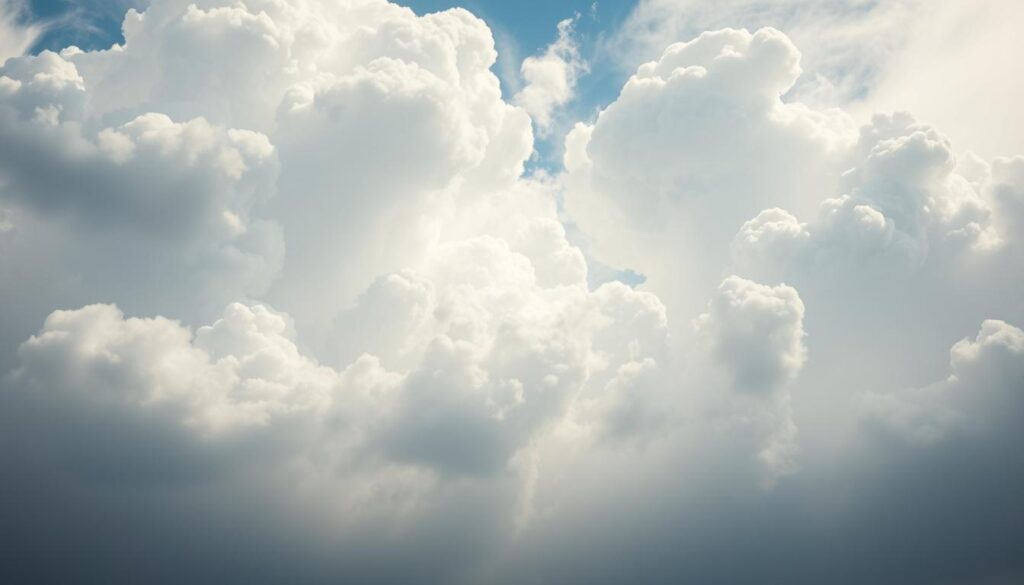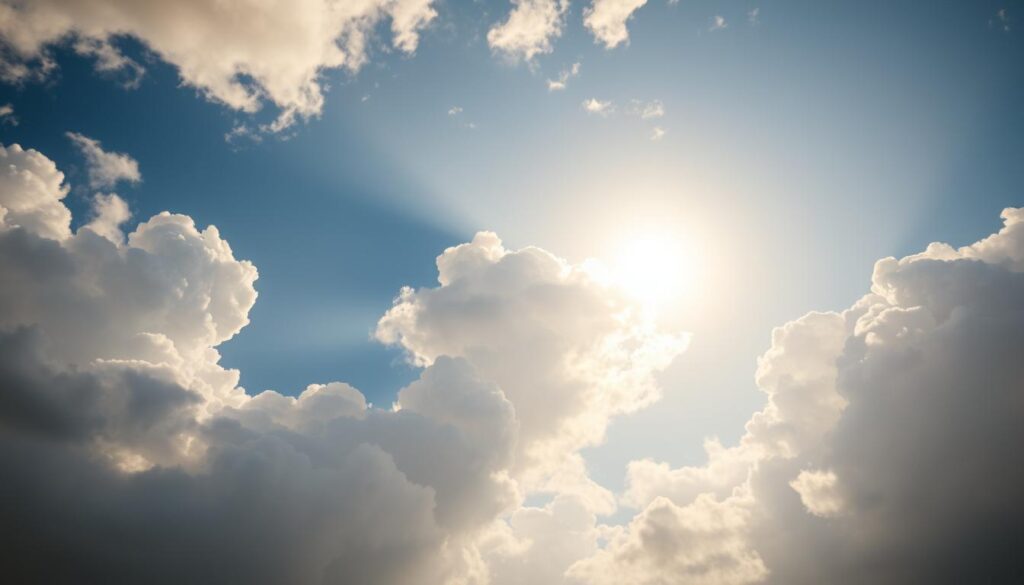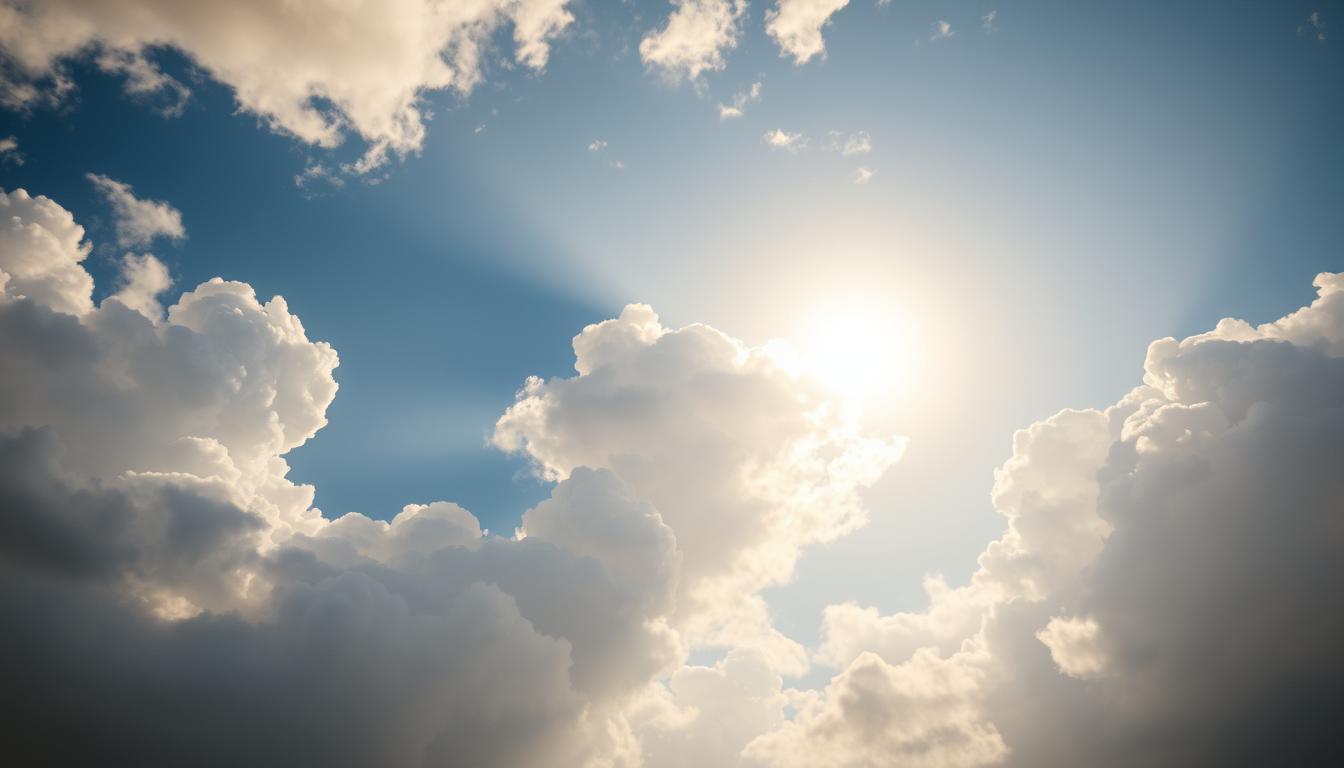When we look up at the sky, we often see face-shaped clouds. These clouds have amazed people for centuries. They can look like simple shapes or complex faces, showing us the sky’s beauty.
Face-shaped clouds are a wonder that people worldwide enjoy. They spark our imagination and curiosity about the sky.

Studying face-shaped clouds is exciting. It teaches us about the science behind them and why we see faces in the sky. By exploring these clouds, we learn to appreciate the beauty and complexity of the sky.
Whether you love clouds or just enjoy nature, face-shaped clouds will amaze and inspire you.
Introduction to Face-Shaped Clouds
Face-shaped clouds are a type of cloud formation in the sky. They show the natural beauty and wonder of the sky. By learning about face-shaped clouds, we understand their science and why we see faces in the sky.
Key Takeaways
- Face-shaped clouds are a type of cloud formation that can be seen in the sky
- Cloud formations can range from simple shapes to complex faces
- The study of face-shaped clouds is an exciting area of exploration
- We can learn about the science behind the formation of face-shaped clouds
- Face-shaped clouds can inspire our imagination and curiosity about sky wonders
- Cloud formations and sky wonders are a great example of the natural beauty of our world
The Fascinating World of Face-Shaped Clouds Appearing in the Sky
Face-shaped clouds are a fascinating sight in the sky. They capture the imagination of people everywhere. These clouds form due to wind, temperature, and humidity in the atmosphere. Studying them helps us understand the science behind these sky wonders.
Clouds come in many shapes, from simple to complex. They are classified by their shape, height, and other features. Observing these clouds is both fun and educational. It lets us see the beauty and complexity of our atmosphere. Some clouds can look like faces, including:
- Cumulus clouds, which look like puffy white clouds with flat bases
- Stratus clouds, which form a uniform layer of cloud cover
- Cirrus clouds, which appear as thin, wispy lines or tufts in the sky
Face-shaped clouds can be seen in different parts of the world. Their formation depends on weather, temperature, and humidity. By studying these clouds, we learn more about our atmosphere and environment.
Understanding Cloud Formation and Pareidolia
Clouds have always fascinated us with their changing shapes. Seeing faces in clouds is a common phenomenon known as pareidolia. But what exactly is pareidolia, and how does it connect to cloud formation?
Cloud formation is a complex process. It involves temperature, humidity, and wind patterns. These factors create the unique shapes we see in clouds. Our brains are wired to recognize patterns, including faces, which is key in human communication.
What is Pareidolia?
Pareidolia is when we see patterns or images in random things. This includes seeing faces in clouds, hearing hidden messages in music, or shapes in rocks.
The Science Behind Cloud Formation
Cloud formation is complex. It involves temperature, humidity, and wind patterns. There are different types of clouds, like cirrus, cumulus, and stratus, each with its own formation process.
Why We See Faces in Clouds
Our brains are wired to recognize patterns, especially faces. This is crucial for human communication. When we look at clouds, our brains try to make sense of the shapes. Recognizing faces is one way to do this.
Common Types of Cloud Formations That Create Facial Features
Cloud formations have always amazed people with their shapes that look like faces. Studying these formations helps us understand the sky better. We’ll look at cumulus, stratus, and cirrostratus clouds that make facial features.
These clouds can form complex faces, like eyes, noses, and mouths. Each cloud type’s shape, size, and texture helps create these features. For instance, cumulus clouds look like puffy white noses or mouths. Stratus clouds, being flat and layered, can look like eyes.
Some common cloud formations that create facial features include:
- Cumulus clouds, which can appear as puffy white clouds that resemble a nose or a mouth
- Stratus clouds, which can appear as a flat, layered cloud that can create the illusion of eyes
- Cirrostratus clouds, which can appear as a thin, uniform cloud that can create the illusion of a face
Studying cloud formations and their role in creating facial features is key to understanding the sky. By looking at different cloud types and how they combine, we appreciate the atmosphere’s beauty and complexity. Whether you’re a cloud enthusiast or just starting, these natural wonders inspire wonder and fascination.
The Psychology Behind Recognizing Faces in the Sky
Face recognition is key to human psychology. It shapes how we see clouds. Seeing faces in clouds is common, thanks to our brain’s ability to recognize faces.
Studies show face recognition helps us in social situations. It’s crucial for our survival and happiness. Seeing faces in clouds shows how powerful our facial recognition is.
Evolutionary Aspects of Face Recognition
Face recognition has evolved over time. It’s linked to cloud pareidolia, seeing patterns in clouds. Our brain tries to make sense of what it sees, influenced by our experiences.

Cultural Interpretations
Cultures view clouds differently, with various meanings. In some places, clouds mean good luck, while others see them as bad signs. These views shape what we see in clouds.
Scientific Studies on Cloud Pareidolia
Research on cloud pareidolia reveals its psychological roots. Our brain’s face recognition system is active when we see clouds. This activity releases dopamine, making it a pleasurable experience.
Historical Significance of Face-Shaped Clouds
Face-shaped clouds have always caught our attention, holding a special place in many cultures. They are found in ancient myths and legends, linked to gods and goddesses. For instance, in ancient Greek stories, clouds were seen as the gods’ domain. Face-shaped clouds were thought to signal divine presence.
These clouds also show up in art and literature, making them famous. Many artists have painted them, and they’re a favorite in poetry and stories. Their historical significance shows how much they’ve meant to us over time.
Some key moments in history include:
- Ancient Greek and Roman myths, where clouds were believed to be the realm of the gods
- Medieval European art, where face-shaped clouds were often depicted in paintings of biblical scenes
- Modern literature, where face-shaped clouds have been used as a metaphor for the human condition
In summary, face-shaped clouds have a deep history and cultural value. They reflect their lasting charm and the important role they’ve played in our culture. By looking into their history, we can better understand their cultural significance and why they still captivate us.
Best Times and Conditions for Spotting Face-Shaped Clouds
Cloud spotting is fun for everyone. To see face-shaped clouds, know the best weather and places. Weather conditions like clear skies and gentle winds help a lot.
Optimal Weather Conditions
High pressure systems are great for clouds. Also, areas near weather changes, like fronts, are good too.
Geographic Locations
Some places, like mountains and coasts, get more clouds. This is because they have more moisture in the air.

Time of Day Considerations
The best times for cloud spotting are early morning and late afternoon. The sun’s position makes clouds stand out. Knowing this can help you see more face-shaped clouds. Enjoy cloud spotting in various geographic locations and weather conditions.
Photography Tips for Capturing Cloud Faces
Cloud photography is a fascinating genre that requires patience, timing, and practice. To capture stunning cloud faces, it’s essential to understand the basics of photography. This includes how to apply them to this unique subject. When it comes to capturing cloud faces, lighting is crucial, as it can make or break the shot.
Here are some valuable photography tips for capturing cloud faces:
- Use a polarizing filter to enhance the contrast and colors of the clouds
- Experiment with different angles and compositions to add depth and interest to the image
- Pay attention to the cloud formations and wait for the perfect moment to capture the face-shaped clouds
By following these tips and practicing your skills, you can capture breathtaking cloud faces. These images will leave a lasting impression. Always keep your camera ready, as the perfect shot can appear at any moment.
With the right equipment, technique, and patience, you can take your cloud photography to the next level. You’ll create stunning images that showcase the beauty of capturing cloud faces.
Famous Face-Shaped Cloud Sightings Around the World
From the “Face of God” to the “Cloud Angel,” famous cloud sightings have amazed people everywhere. These cloud face phenomena have become a big part of our shared culture. They often go viral on social media, inspiring and amazing us all.
Looking at some famous cases shows how diverse and complex cloud face phenomena can be. Some of the most famous include:
- The “Face of God,” a cloud that looks like a human face, often linked to divine or spiritual themes
- The “Cloud Angel,” a shape that looks like a winged figure, symbolizing hope and protection
- The “Smiling Cloud,” a shape that looks like a smiling face, often seen as a sign of joy and happiness
These famous cloud sightings have become a big part of social media. They have also inspired art and culture. The effect of viral clouds on our imagination is clear, with many sharing their own photos and stories. As we keep marveling at these wonders, we remember the beauty and mystery around us.
The Role of Technology in Cloud Pattern Recognition
Cloud pattern recognition is key to understanding weather and climate. Technology, like artificial intelligence, helps us analyze clouds better. It uses machine learning to spot patterns in clouds, helping us predict weather and climate shifts.
Technology in cloud pattern recognition has many uses. It can make weather forecasts more accurate, helping avoid disasters and save lives. It also aids in studying climate change and its environmental impacts. Artificial intelligence can find patterns in cloud data that humans might miss.
Some main benefits of using technology in cloud pattern recognition are:
- More accurate weather forecasts
- Deeper understanding of climate change
- More efficient data analysis
In summary, technology like cloud pattern recognition and artificial intelligence is changing how we see weather and climate. By studying cloud patterns, we can better understand our world. This knowledge helps us make smarter choices to protect our environment.
Weather Phenomena That Enhance Cloud Face Formations
Cloud face formations are truly captivating. Weather phenomena play a big role in making them look even more amazing. The way the atmosphere and wind patterns work together creates these unique cloud shapes. Wind patterns are especially important in forming these recognizable face shapes.
Things like temperature and humidity also affect cloud face formations. The right mix of these factors can make stunning cloud faces that amaze everyone. Let’s look at how weather phenomena help create these amazing cloud faces:
- Wind patterns: Wind direction and speed can shape clouds into various forms, including face shapes.
- Atmospheric conditions: Temperature, humidity, and other atmospheric factors influence the formation and persistence of cloud faces.
Understanding how weather phenomena work together helps us appreciate cloud face formations more. Next time you see a face-shaped cloud, think about the weather that made it possible.
Conclusion: Embracing Nature’s Celestial Portraits
As we wrap up our journey through face-shaped clouds, it’s clear they connect us deeply to our world’s beauty. They show us the science behind their creation and their cultural importance. These clouds ask us to stop, admire, and value the sky’s vast beauty.
If you love watching clouds or just enjoy seeing faces in them, embracing these celestial portraits is rewarding. Learning about the atmospheric conditions that create them helps us appreciate our environment’s dynamic nature.
Keep looking up, have your camera ready, and keep your wonder alive as you explore face-shaped clouds. Share your cloud sightings and thoughts with others. This way, you help build a community that loves and celebrates nature’s art. The more we notice and value these wonders, the more we understand our world.
FAQ
What is Pareidolia?
Pareidolia is when our brains see patterns or images, like faces, in random things. This is why we often see shapes and features in clouds.
What are the common types of cloud formations that create facial features?
Clouds like cumulus, stratus, and cirrostratus can form faces. They mix in different ways to create eyes, noses, and mouths.
Why are we wired to see faces in clouds?
Our brains are wired to spot faces quickly. This is because it helped our ancestors survive. It’s a natural ability to recognize faces, even in unclear patterns.
What are some of the best times and conditions for spotting face-shaped clouds?
Spotting face-shaped clouds is best on clear days with gentle winds. The right time of day and location, like mountains or coasts, also helps.
How can technology help with cloud pattern recognition?
New tech like AI and machine learning can improve cloud recognition. They help in weather forecasting and understanding cloud dynamics.
What weather phenomena can enhance cloud face formations?
Wind and weather conditions like temperature and humidity shape cloud faces. These factors make cloud formations change and evolve.
